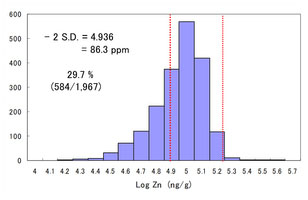Research Abstract
メタロミクス解析による自閉症児の評価
Estimation of autistic children by metallomics analysis
2013年2月4日 Scientific Reports 3 : 1199 doi: 10.1038/srep01199

自閉症スペクトラム障害の発症原因と治療法の解明は今日の課題の1つである。今回我々は、自閉性障害を持つ1,967人の子供(1,553人の男子と414人の女子)に対して、頭髪の26種の微量元素濃度を調べた。584(29.7%)、347(17.6%)および114(5.8%)人の被験者に亜鉛、マグネシウムおよびカルシウムの不足がそれぞれ認められ、その他の必須金属においては2.0%以下であった。ミネラル不足の発現率は、0~3歳の幼児に多く観察された。その一方で、339(17.2%)、168(8.5%)および94(4.8%)人は、アルミニウム、カドミウムおよび鉛の多量の蓄積に、そして2.8%もしくはそれ以下が水銀およびヒ素の蓄積に曝されていることが分かった。これらの知見は、幼児期の亜鉛やマグネシウムの不足、および有毒金属の蓄積の両方もしくはいずれか一方が、自閉性障害における環境因子としてエピジェネティックな役割を果たしていること、そしてメタロミクス解析法が神経発達障害の早期スクリーニングや予防につながる可能性があることを示唆している。
安田 寛1, 安田 雄一2 & 筒井 豊春1
- ら・べるびぃ予防医学研究所
- 健康科学研究所
Clarification of the pathogenesis and treatment of autism spectrum disorders is one of the challenges today. In this study, we examine scalp hair concentrations of 26 trace elements for 1,967 children with autistic disorders (1,553 males and 414 females). Five-hundred and eighty-four (29.7%), 347 (17.6%) and 114 (5.8%) subjects was found deficient in zinc, magnesium and calcium, respectively, and 2.0% or less in the other essential metals. The incidence rate of mineral deficiency was highly observed in infants aged 0-3 year-old. In contrast, 339 (17.2%), 168 (8.5%) and 94 (4.8%) individuals was found suffering from high burden of aluminium, cadmium and lead, and 2.8% or less from mercury and arsenic burden. These findings suggest that infantile zinc- and magnesium-deficiency and/or toxic metal burdens may epigenetically play principal roles as environmental factors in autistic disorders and that metallomics approach may lead to early screening and prevention of the neurodevelopment disorders.

